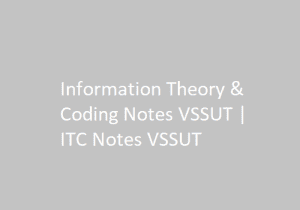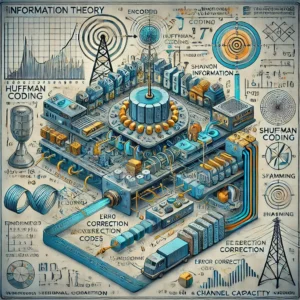Limited Offer Get 350+ professional resume templates for just Rs. 99

Study Abroad We Will Help You to Fill Your Dream
Information Theory And Coding Notes VSSUT – ITC Notes VSSUT of Total Complete Notes

Please find the download links of Information Theory and Coding Notes VSSUT | ITC Notes VSSUT are listed below:
Link: Complete Notes
Link: Module – 1
Link: Module – 2
Link: Module – 3
Link: Module – 4
Information Theory and Coding Notes PDF – ITC Notes PDF


Are you looking for comprehensive notes on Information Theory and Coding for your B.Tech studies at VSSUT? You’ve come to the right place! This page provides access to downloadable ITC Notes PDF that align with the latest syllabus, offering a thorough understanding of information theory, source coding, error control, and advanced coding techniques.
Information Theory and Coding PDF Lecture Notes – VSSUT
The Information Theory and Coding Notes PDF is meticulously prepared for B.Tech students at VSSUT, following the university’s syllabus for the 2024 academic year. These notes provide a structured overview of key topics such as information theory, source coding, waveform coding, convolutional encoding, Reed-Solomon codes, and turbo codes. This knowledge is essential for understanding modern digital communication systems and data transmission reliability.
Overview of Information Theory and Coding Notes PDF
The ITC Notes PDF is organized according to the VSSUT syllabus and covers four detailed modules. These modules focus on the fundamentals of information theory, coding techniques, error control strategies, and the mathematical principles underlying data communication systems. This structured approach ensures students gain a comprehensive understanding of both theoretical and practical aspects of information and coding theory.
Topics Covered in Information Theory and Coding Handwritten Notes
Here’s a breakdown of the topics covered in each module of the Information Theory and Coding course. These notes offer detailed explanations, mathematical derivations, and real-world examples to help students master each topic effectively.
Module 1: Information Theory and Source Coding
- Introduction to Information Theory: Fundamental concepts of information theory, including the measurement of information, uncertainty, and entropy.
- Mutual Information and Entropy: Exploration of average mutual information and entropy for discrete and continuous random variables.
- Source Coding Techniques: Introduction to various source coding techniques, including block coding and vector quantization.
- Amplitude Quantizing and DPCM: Detailed study of quantizing noise, uniform and non-uniform quantizing, and differential pulse code modulation (DPCM), including one-tap and N-tap prediction.
- Advanced Modulation Techniques: Sigma-delta modulation and the working principles of sigma-delta A-to-D and D-to-A converters.
- Transform Coding: Concepts of transform coding and quantization for transform coding, including applications in data compression.
Module 2: Waveform Coding
- Signal Types and Coding: Analysis of antipodal, orthogonal, and biorthogonal signals and their implications in waveform coding systems.
- Error Control Strategies: Overview of different types of error control mechanisms, including terminal connectivity and automatic repeat request (ARQ).
- Channel Models and Capacity: Understanding channel models, channel capacity, and the Information Capacity Theorem.
- Error Correcting Codes: Introduction to error-correcting codes, code rate, redundancy, and parity check codes, including single parity check and rectangular codes.
- Linear Block Codes: Fundamentals of linear block codes and their application in digital communication.
Module 3: Convolutional Encoding
- Convolutional Encoder Representation: Detailed study of convolutional encoder representation, including connection representation, state diagrams, tree diagrams, and trellis diagrams.
- Convolutional Decoding: Formulation of the convolutional decoding problem, maximum likelihood decoding, and channel models for hard versus soft decisions.
- Viterbi Algorithm: Application of the Viterbi convolutional decoding algorithm, with examples and decoder implementation techniques.
- Properties of Convolutional Codes: Exploration of distance properties, systematic and nonsystematic convolutional codes, and their applications.
Module 4: Reed-Solomon Codes and Turbo Codes
- Reed-Solomon Codes: Understanding the Reed-Solomon error probability, performance against burst noise, and the impact of size, redundancy, and code rate on performance.
- Interleaving and Concatenated Codes: Techniques for block interleaving, convolutional interleaving, and concatenated codes to improve error correction.
- Applications in Digital Audio Systems: Application of coding and interleaving in CD digital audio systems, including CIRC encoding and decoding, interpolation, and muting.
- Turbo Codes: Introduction to turbo codes, their concepts, and log-likelihood algebra used in decoding.
Links to Download ITC Notes PDF
To assist with your studies, we have provided direct download links for each module and the complete set of notes:
These resources are perfect for thorough revision and gaining an in-depth understanding of the subject matter.
Benefits of FREE ITC Handwritten Notes PDF
- Comprehensive Coverage: These notes cover all critical topics, providing a detailed understanding of information theory, coding techniques, and error correction methods.
- Free and Accessible: These notes are available for free download, ensuring all students have access to quality study materials.
- Expertly Compiled: Prepared by subject experts, ensuring high-quality, accurate, and reliable content.
- Easy to Understand: Handwritten notes provide clarity and a more personalized approach, making complex topics easier to comprehend.
- Ideal for Exam Preparation: Detailed explanations, mathematical derivations, and structured content make these notes perfect for exam preparation.
FAQs About Information Theory and Coding Notes PDF
Q1. Where can I download the Information Theory and Coding Notes PDF?
- You can download the notes from the provided links for each module or the complete set from Smartzworld.
Q2. How to download the ITC Notes PDF?
- Simply click on the download links provided above for each module or the complete set of notes.
Q3. How many modules are covered in the ITC Notes PDF?
- The ITC Notes PDF covers four modules, each focusing on different aspects of information theory and coding techniques.
Q4. What topics are covered in the ITC Notes PDF?
- Topics include information theory, source coding, waveform coding, convolutional encoding, Reed-Solomon codes, and turbo codes.
Q5. Where can I get the complete ITC Handwritten Notes PDF for free download?
- The complete ITC Handwritten Notes PDF is available for free download from Smartzworld.
Q6. How to download ITC Handwritten Notes PDF?
- You can download the handwritten notes using the provided links above on this page.
Q7. How to Download FREE ITC Notes PDF?
- All notes are freely accessible; just click on the download links above to get your copy.
Always choose Smartzworld to download ITC Notes PDF for reliable, comprehensive study materials that cater to your learning needs in Information Theory and Coding. Whether you’re preparing for exams or enhancing your understanding of digital communication and data transmission, these notes are an invaluable resource for academic success.
How useful was this post?
Click on a star to rate it!
Average rating 5 / 5. Vote count: 15
No votes so far! Be the first to rate this post.

